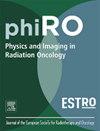Cone-beam computed tomography reconstruction for a commercial proton beam therapy system
IF 3.3
Q2 ONCOLOGY
引用次数: 0
Abstract
Background & Purpose:
Cone-beam computed tomography (CBCT) images are used in image-guided radiotherapy to track anatomical changes throughout treatment and to set up patients to ensure accurate delivery of therapeutic radiation at each treatment session. An offline method of CBCT reconstruction workflow, operating on 2D projection images and specific to the imaging system in question, is needed for many image optimisation studies. Here we present a methodology to reconstruct CBCT images from these data for a commercial proton beam therapy machine, accounting for the variation in exposure and beam hardening from filtration due to gantry rotation during CBCT acquisition.
Materials & Methods:
Projection data of solid water phantoms were acquired to model bow-tie filter motion and beam hardening effects. Projection data and system CBCT reconstructions of a Catphan504 phantom were acquired for validation of the method, as well as a retrospectively accessed patient image. The presented workflow was assessed against the clinical reconstructions using uniformity, signal-to-noise-ratio, and contrast-to-noise-ratio measured in the phantom images.
Results:
The offline workflow eliminated crescent artefacts due to variable exposure and beam hardening in phantom and patient images. Signal-to-noise and contrast-to-noise ratios were similar compared to system reconstructions, although with slight differences thought to be due to interplay effects in the bow-tie filter.
Conclusion:
A workflow was developed to emulate the CBCT reconstruction process for a commercial proton therapy machine, providing a useful tool for optimised acquisition parameters and novel reconstruction processes using this system.
商用质子束治疗系统的锥束计算机断层扫描重建
背景,目的:锥形束计算机断层扫描(CBCT)图像用于图像引导放射治疗,以跟踪整个治疗过程中的解剖变化,并确定患者以确保每次治疗期间准确提供治疗性放射。许多图像优化研究都需要一种CBCT重建工作流程的离线方法,该方法在2D投影图像上操作,并且特定于所讨论的成像系统。在这里,我们提出了一种从这些数据重建CBCT图像的方法,用于商业质子束治疗机,考虑到CBCT采集过程中由于龙门架旋转而导致的暴露变化和光束硬化。材料,方法:获取固体水影投影数据,模拟领结滤光片运动和光束硬化效应。为了验证该方法,获得了Catphan504幻影的投影数据和系统CBCT重建,以及回顾性访问的患者图像。根据临床重建使用均匀性,信噪比和对比噪声比在幻影图像中测量的工作流程进行评估。结果:离线工作流程消除了由于幻影和患者图像中的可变曝光和光束硬化而导致的新月形伪影。与系统重建相比,信噪比和对比噪声比相似,尽管由于领结滤波器的相互作用而存在细微差异。结论:开发了一个工作流程来模拟商用质子治疗机的CBCT重建过程,为优化采集参数和使用该系统的新重建过程提供了有用的工具。
本文章由计算机程序翻译,如有差异,请以英文原文为准。
求助全文
约1分钟内获得全文
求助全文
来源期刊

Physics and Imaging in Radiation Oncology
Physics and Astronomy-Radiation
CiteScore
5.30
自引率
18.90%
发文量
93
审稿时长
6 weeks
 求助内容:
求助内容: 应助结果提醒方式:
应助结果提醒方式:


